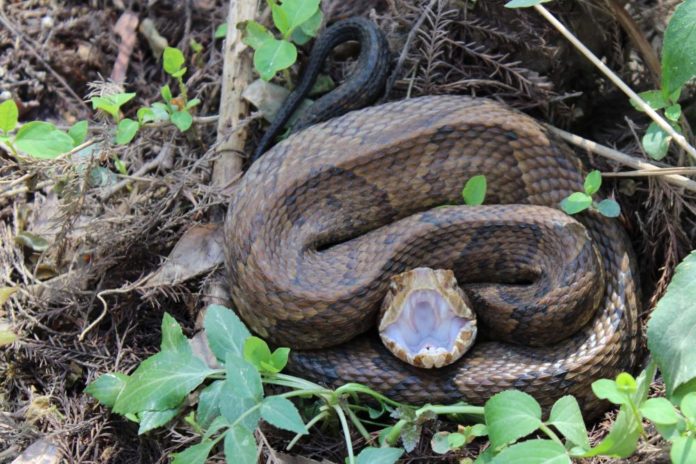AUBURN UNIVERSITY, Ala. – Alabama is home to one of the most diverse wildlife populations in the country. In fact, Alabama consistently ranks among the top five states in overall biodiversity. Included in this population, are over 50 species of snakes. While most are non-venomous, Alabama is home to six species of venomous snakes. Deaths from snakebites are relatively uncommon in Alabama, however it is important to know how to identify and avoid these snakes.
Six Venomous Snakes
Bence Carter, an Alabama Extension forestry, wildlife and natural resources regional agent, said the six venomous snakes of Alabama include the Eastern coral snake, copperhead, cottonmouth, Eastern diamondback, timber rattlesnake and pigmy rattlesnake.
“There are six venomous snake species in Alabama, five of them falling into the category of pit vipers,” Carter said. “The Eastern coral snake is the single venomous species not falling into the pit viper category.”
Pit vipers have a broad, triangular shaped head, a heavy body relative to their length, vertical pupils and a single row of scales on the belly below the anal scales.
Carter said the term “pit viper” refers to the pit organs between the eyes and nostril.
“These organs detect infrared radiation emitted by warm-blooded prey species,” he said. “This sensory organ is used to detect variations in temperature, particularly when hunting.”
There are some non-venomous snakes that may flatten their heads to give a more triangular shape. Therefore, it is better to know and recognize the distinctive patterns of venomous snakes.
Copperhead
Copperheads are medium-sized snakes that have distinct copper-red heads and hourglass-shaped markings across their backs. The average length of these snakes is between 2 and 3 feet. Copperheads color patterns vary, but typically they have dark brown hourglass like markings on a lighter brown background. When disturbed, they usually vibrate their tail rapidly and may give off a strong, musky scent. These snakes are often more defensive at night than during the day.
Cottonmouth
Also known as water moccasins, cottonmouths get their name for the white color of the inside of their mouths. They often show their mouths when they are feeling territorial or are ready to strike. You most often find these snakes living in areas around water including rivers, lakes, streams and swamplands. Young cottonmouths have a lighter colored background with dark-brown bands. The adults generally appear darker brown to black in color. These snakes also have a dark band that covers the eyes and sides of the face. Cottonmouths are large, heavy-bodied snakes and can reach lengths between 30 and 48 inches.
Eastern Diamondback Rattlesnake
Eastern diamondbacks are the largest venomous snake in Alabama. These snakes can reach a length of more than 7 feet. Their name comes from the dark brown, diamond-shaped patterns that extends down their backs. Eastern diamondbacks live primarily in the lower coastal plains of the state, generally living in drier areas such as pine flatwoods, coastal scrub habitats and sandy woodlands.
Timber Rattlesnake
Timber rattlesnakes, sometimes referred to as canebrake rattlesnakes, live in all areas of Alabama. They are a fairly large snake, reaching lengths up to 6 feet. Their coloring is usually a combination of yellow and dark brown markings, however, there have been snakes found with a gray color with black markings. The timber rattlesnake’s darker markings often appear in a bent crossband or chevron pattern. Their coloration makes it hard to detect them in forested areas.
Pigmy Rattlesnake
As their name suggests, pigmy rattlesnakes seldom reach lengths greater than two feet. While they live throughout the state, they are seldom seen. These snakes are light brown or gray in color, with dark brown or black markings running along their back. Their small rattles can rarely be heard more than 3 feet away.
Eastern Coral Snake
Not only are Eastern coral snakes the most venomous snakes in Alabama, they are the most venomous snake native to the United States. They are distinctly known for their red, yellow and black bands—with the red and yellow bands touching. Because there are non-venomous snakes that have similar markings, the phrase “red touching yellow, kill a fellow; red touches black, a friend of Jack” is commonly used to help distinguish them from other species.
However, according to Carter, there have been reports of some variations in color patterns. The one thing that always holds up is the black color of their snout. Eastern coral snakes are rarely seen and generally live underground in loose soils. While primarily found in south Alabama, there have been sightings as far north as Coosa County.
Common Look-A-Likes
Carter said there are some non-venomous snakes that resemble venomous species.
“Many water snake species, typically found in or around water, are commonly mistaken for cottonmouths,” Carter said. “Several species might have patterns, bandings or dark colorings that, at first glance, look similar to a cottonmouth. However, after further examination, they are distinguishable.”
There are three non-venomous species, scarlet snakes, scarlet kingsnakes and red milk snakes, that have similar markings to those of the Eastern coral snake. However, in these species the yellow bands touch black and not red.
According to Carter, there are some non-venomous species that might even try to flatten their heads or bodies to look more ominous when they feel threatened.
Dealing With Snakes and Snakebites
If encountering a venomous snake, Carter said the best thing to do it give it space.
“Avoid attempting to pick up or move the snake. Give the snake its space and leave it alone,” he said. “Do not get between the snake and cover or brush, as it may just try to escape.”
If bitten by a venomous snake, it is important to seek medical help immediately.
“While waiting on medical assistance, it is important to remain as calm as possible,” Carter said. “Also, remove any tight-fitting jewelry or clothing, as swelling near the bite area may occur.”
Carter said to try and remember distinguishable characteristics of the snake such as color, patterns, shape, etc.
“If it does not delay medical treatment, from a safe distance take a picture of the snake, for positive identification if possible,” Carter said. “Do not try to capture or kill the snake, as venomous snakes can still be capable of envenomation after death.”
More Information
Alabama Extension has the publication Identification and Control of Snakes in Alabama that has more information about the snakes that call Alabama home. For further information, contact your county Extension forestry, wildlife and natural resources agent.
































